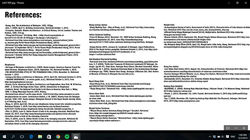top of page
CULTURE & HISTORY II
 |
|---|
 |
 |
 |
 |
 |
 |
 |
 |
 |
PROJECT I: Timeline
The Project requires students to undertake a research analysis process on Modern Malaysian architecture practices throughout history through literature review and document analysis and present an appropriate chronology account of the Malaysian architecture based on the understanding gained through the analysis procedure. It also familiarizes students to the activities of culmination and production of a research analysis through assemblage, chronologically indices and evaluation of information; composing and organization of study; assembly of illustration and text; design layout composition; poster and presentation.
The greatest architectural transformation followed Merdeka, or Independence in 1957. Kuala Lumpur and other parts of Malaysia was transformed from a colonial town into the new nation and Kuala Lumpur the new nations capital. Proud symbols of nationhood were expressed in new and daring forms. Innovative construction techniques and industrialized components changed the scale of commercial buildings and enabled the erection of the first prominent buildings and sky scrapers that shaped the nations architectural modern scene. According to Ar. Chan Seong Aun, president of Persatuan Akitek Malaysia (2013-2015), most Malaysian architecture of the modern movement are not documented thoroughly and have not made the list of heritage buildings. The Subang airport for example has been replaced by a non descript warehouse. It is therefore important that we properly record the heritage of Malaysian architecture before it is destroyed and lost forever. This research project adopts document analysis methodology that involves documenting, analyzing, producing, and presenting orally a critical chronological interpretation of Modern Malaysian architectural history. This project emphasizes critical analysis of the post Merdeka/Independance of Malaysian architecture in the effort to understand the influences of post-modernism to architectural design and construction, building science and technology, and urban design. The project is to distinguish the way in which many diverse factors contribute to the development of Modern Malaysian architecture. The development of the project would involve active discussion, analysis interpretation and consultation with the tutor.
PROJECT 2 (Individual): Online Web Book
This project requires students to increase understanding on the principle, ideas and contributing factors of Modern Architecture in Klang Valley enabling them to analyze and identify specific architectural features of Modern Architecture in Klang Valley also documenting architectural heritage in the form of writings, descriptive diagrams and photography in relation to creating a web book as a means to publish academic materials.
Klang Valley is a rich source of architectural heritage dated from pre-colonial, colonial, post independence until present times. The historical richness creates a very vibrant architectural fabric. The modern architecture emerges rapidly from 1950’s to 1970’s as the economic growth spurs. This follows the international style that spreads across the world in 1930’s to 50’s. However, many historical modernistic buildings may face risk of being demolished to make way for more contemporary buildings. Thus, by recording, documenting and analysing the buildings, we can contribute to preserve the historical evidence of the valuable Modern Architecture in Klang Valley. The findings are to be compiled in essays and to be submitted using a web book platform. Web book is a publication in digital form, consisting of text (report), images, or both.
bottom of page
